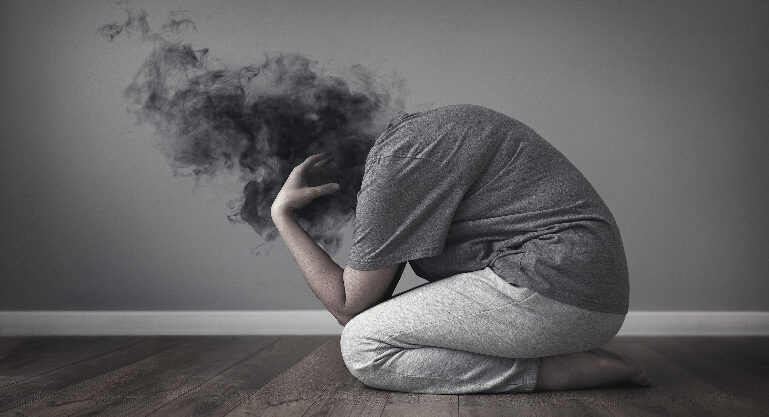Depression isn’t just “feeling sad.” Clinically, it’s a cluster of depression symptoms that persist most of the day, nearly every day, for at least two weeks and interfere with work, school, relationships, or daily life. Core features are low mood and/or loss of interest or pleasure (anhedonia), plus several additional symptoms listed below. source
The big picture (what clinicians look for)
Common symptoms include:
- Low mood (sad, empty, hopeless) or irritability (especially in teens).
- Loss of interest/pleasure in hobbies, sex, or socializing.
- Appetite or weight changes (up or down).
- Sleep problems (insomnia or oversleeping).
- Fatigue/low energy nearly every day.
- Psychomotor changes (moving/talking slower, or feeling keyed up).
- Poor concentration/indecisiveness.
- Feelings of worthlessness or excessive guilt.
- Recurrent thoughts of death or suicide.
For a diagnosis, you need multiple symptoms (with at least one of the first two), present most days for 2+ weeks, and causing real-life impairment. source
How it shows up in real life
- Emotionally: persistent sadness, numbness, or irritability.
- Cognitively: brain fog, negative thinking, “I’m a burden,” can’t decide simple things.
- Physically: headaches, digestive issues, body aches, changes in appetite/sleep.
- Behaviorally: pulling away from friends, missing work/classes, slowed actions, or restless pacing.
Authoritative patient resources list these same patterns and emphasize that not everyone feels “sad”; some feel mostly empty, anxious, or irritable. source
Adults vs. teens vs. older adults
- Teens: irritability may replace sadness; look for dropping grades, sleep/appetite shifts, loss of interest in activities, and self-injury risks. source
- Older adults: more physical complaints (pain, fatigue), withdrawal, or cognitive concerns; depression is often missed and not “just aging.” source
“Am I depressed?” (Quick screening)
Clinicians often use the PHQ-9, a 9-item questionnaire mirroring the diagnostic symptoms. It helps screen, track severity, and guide care, but it’s not a standalone diagnosis. If your PHQ-9 is elevated or you recognize yourself here, talk with a clinician.
When to get help, urgently
If you’re having thoughts of suicide, feeling you’d be better off dead, or making a plan, get help now: Call or text 988 (U.S. Suicide & Crisis Lifeline) or start a chat at 988lifeline.org. It’s free, confidential, and 24/7. Learn warning signs and how to help at NIMH. source
Hence:
Depression is a whole-person condition affecting mood, thinking, body, and behavior. The pattern, duration (≥2 weeks), and impact on daily life are what separate it from a rough week. If this sounds like you, reaching out is a strength, and effective treatments exist.
How Ayurveda Interprets the Signs of Depression
Ayurveda doesn’t reduce depression to one label. It asks: Which dosha is out of balance? How are Agni (digestion), Ojas (vital resilience), and the mind’s Gunas (Sattva–Rajas–Tamas) behaving? That map explains why symptoms look different person to person, and points to tailored support.
1) Dosha Patterns You’ll Recognize
Vata-type depression (air/space)
- Mood/energy: anxious low, emptiness, “hollow” sadness; mood swings; scattered focus.
- Body cues: dry skin/lips, cold hands/feet, twitchiness, constipation or gas.
- Mind: racing thoughts, worry loops, indecision, insomnia (hard to fall asleep).
- Daily pattern: worse late evening/night; second wind at midnight; appetite irregular.
- Common triggers: irregular routines, too much screen/news, travel, skipping meals.
Pitta-type depression (fire)
- Mood/energy: irritable low, self-criticism, perfectionism > burnout; anger turned inward.
- Body cues: acid reflux/heartburn, heat/sweating, headaches; red/irritated skin.
- Mind: rumination about failures, harsh inner voice, can’t “switch off.”
- Daily pattern: spikes midday/afternoon; wakes 2–3 a.m. planning or stewing.
- Common triggers: overwork, competition, caffeine/spicy foods, hot environments.
Kapha-type depression (earth/water)
- Mood/energy: heavy low, foggy, slowed motivation; wants to withdraw; comfort-eating.
- Body cues: weight gain, water retention, sluggish digestion, oversleeping yet tired.
- Mind: numbness, “why bother,” difficulty initiating anything.
- Daily pattern: worst mornings; slow start; improves after movement/fresh air.
- Common triggers: inactivity, heavy/processed foods, oversleeping, isolation.
Many people are mixed:
- Vata–Pitta: anxious + irritable, wired-tired, gut on edge.
- Vata–Kapha: anxious + stuck, low drive but racing thoughts.
- Pitta–Kapha: burned out + heavy, cynical, snappy then withdrawn.
2) The Mind’s Qualities (Gunas)
- Sattva (clarity): calm, purpose, perspective.
- Rajas (agitation): overdrive, restlessness, irritability.
- Tamas (heaviness): inertia, gloom, avoidance.
Depression = Tamas dominating, often after long Rajas (months of go-go-go) or chronic Vata agitation. Restoring Sattva is the north star.
3) Agni, Ama, and Ojas: Why the Body Feels It
- Agni (digestive fire):
- Vishama (irregular) Agni: Vata signs: gas, variable appetite.
- Tikshna (too sharp) Agni: Pitta signs: acidity, loose stools.
- Manda (sluggish) Agni: Kapha signs: heaviness, bloating.
- Vishama (irregular) Agni: Vata signs: gas, variable appetite.
- Ama (toxins): forms when Agni is off – brain fog, coated tongue, foul breath, lethargy.
- Ojas (vital resilience): chronic stress/grief depletes Ojas > fatigue, frequent colds, low glow/enthusiasm.
4) Subtle Early Signs Ayurveda Watches (catch it sooner)
- Tongue: thick white/yellow coat (Ama), scalloped edges (Vata), red tip (Pitta).
- Sleep: hard to fall asleep (Vata), wake hot/irritable at 2–3 a.m. (Pitta), oversleep but unrefreshed (Kapha).
- Cravings: crunchy/cold snacks (Vata), spicy/coffee (Pitta), sweets/dairy/heavy foods (Kapha).
- Breath & chest: shallow/chest-tight (Vata), hot/rapid (Pitta), heavy/dull (Kapha).
- Time of day:
- Morning heaviness > Kapha tilt
- Midday irritability/acid > Pitta tilt
- Late-night worry/insomnia > Vata tilt
- Morning heaviness > Kapha tilt
5) How an Ayurvedic Practitioner Assesses
- Prakriti vs. Vikriti: your baseline vs. current imbalance.
- Darshan/Prashna/Sparsha: observation, detailed questioning (sleep, bowels, appetite, energy), and exam (pulse, tongue, skin).
- Nadi (pulse) reading: qualities pointing to Vata/Pitta/Kapha excess.
This isn’t a quick checklist—it’s a whole-system read of patterns.
6) Quick Self-Check Prompts (Ayurveda-style)
- Do I wake heavy and crave naps (Kapha), or wake hot and keyed-up (Pitta), or can’t fall asleep at all (Vata)?
- Is my appetite steady (Sattva) or chaotic/acidic/sluggish (Vata/Pitta/Kapha clues)?
- Are my low days more anxious, more angry/critical, or more numb/heavy?
- What reliably lightens me—warmth and routine (Vata), cooling/reframing (Pitta), or movement/lightness (Kapha)?
Use the answers to identify your dominant pattern so any practices you add later are targeted, not generic.
7) Red-Flag Symptoms (don’t self-manage these alone)
- Persistent thoughts of self-harm, feeling you’re a burden, or making a plan.
- Rapid decline in functioning (can’t work, care for self/children), or severe appetite/sleep collapse.
- New agitation with risky impulses or signs of mania (little sleep + exaggerated energy).
In the U.S., call or text 988 (Suicide & Crisis Lifeline) or reach local emergency services if you’re in immediate danger. Ayurveda is a complement, not a substitute, for medical/mental-health care.
Key takeaway
From an Ayurvedic lens, the same diagnosis can have three different faces. Spotting whether your depression is Vata-like (anxious/restless), Pitta-like (hot/critical), or Kapha-like (heavy/slowed) explains why your body feels the way it does—and sets you up for targeted, gentle, whole-system support.



